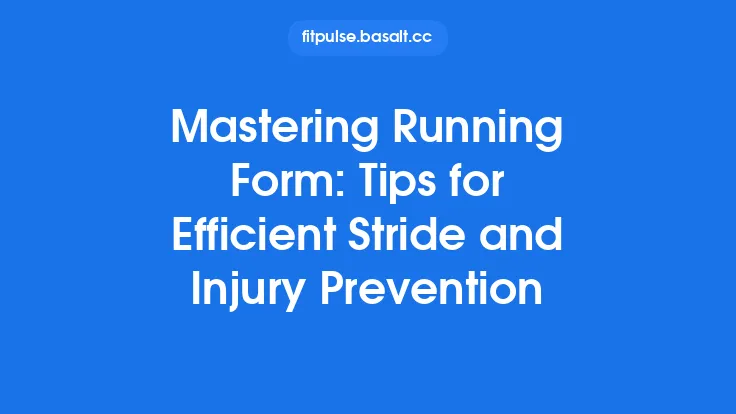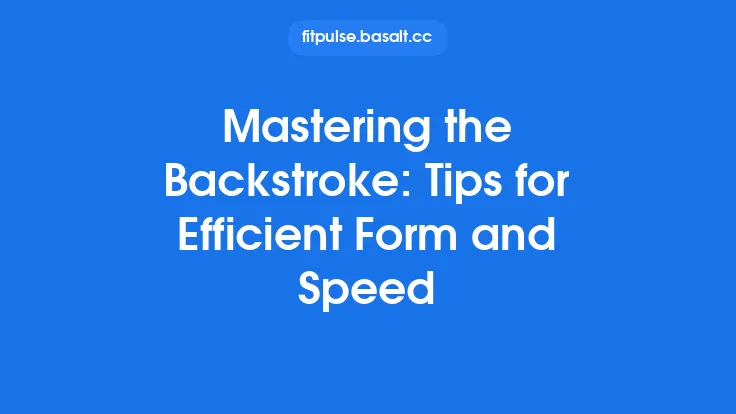Running is a complex, rhythmic activity that relies on the seamless integration of musculoskeletal structures, neural control, and metabolic systems. When the biomechanical components of each stride are aligned efficiently, the runner can maintain higher speeds with less perceived effort and a lower risk of injury. Below is a comprehensive exploration of the core biomechanical principles that underpin an efficient running form, presented in a way that remains relevant for athletes, coaches, and anyone interested in the science of movement.
Fundamental Biomechanical Concepts for Running Efficiency
Efficient running hinges on the optimal use of energy, force, and time. Three interrelated concepts provide the foundation:
- Energy Conservation and Transfer – The body must capture, store, and release mechanical energy with minimal loss. Elastic structures such as the Achilles tendon and the plantar fascia act like springs, converting kinetic energy from one phase of the gait cycle into potential energy that is then returned during push‑off.
- Force Application – Ground reaction forces (GRFs) generated during foot‑ground contact must be directed in a manner that propels the runner forward rather than dissipating energy laterally or vertically. The vector of the resultant GRF should align closely with the runner’s center of mass (COM) trajectory.
- Temporal Coordination – The timing of muscle activation, joint angular velocity, and limb positioning must be synchronized to avoid “dead‑time” where forces are not contributing to forward motion. This coordination is often expressed as the relationship between stride frequency (cadence) and stride length.
Understanding how these concepts interact provides a roadmap for refining technique and improving performance.
Ground Reaction Forces and Their Management
When the foot contacts the ground, the body experiences a rapid increase in vertical and horizontal GRFs. Efficient runners manage these forces through two primary strategies:
- Early Braking Reduction – In the initial contact phase, a large horizontal decelerative force (braking) wastes energy. By landing slightly ahead of the COM and allowing a gentle, progressive loading, the runner minimizes this braking impulse. The resulting GRF vector points more posteriorly, reducing the need for muscular braking.
- Propulsive Alignment – During mid‑stance, the GRF should transition smoothly from a vertical to a forward‑directed component. This shift is facilitated by ankle plantarflexion and hip extension, which channel the vertical impulse into forward propulsion. The peak vertical GRF typically occurs around 20–30% of stance time; efficient runners keep this peak modest, avoiding excessive vertical displacement that would otherwise increase metabolic cost.
Quantitatively, the impulse (integral of force over time) in the horizontal direction should be close to zero for a steady‑state run, indicating that the forward thrust generated during push‑off balances the decelerative forces at landing.
Optimizing Stride Length and Cadence
The product of stride length (SL) and cadence (steps per minute, SPM) determines running speed (v = SL × SPM). However, maximizing either variable independently can compromise efficiency:
- Excessive Stride Length – Over‑striding forces the foot to land far ahead of the COM, increasing braking forces and requiring greater hip extension torque. This not only raises metabolic cost but also elevates the risk of hamstring strain.
- Insufficient Cadence – A low cadence prolongs ground contact time, allowing greater vertical oscillation and reducing the proportion of time spent in the propulsive phase.
Research consistently shows that elite distance runners operate at a cadence of ≈180 steps per minute (±10%) regardless of speed, adjusting stride length rather than cadence to increase velocity. For recreational runners, a practical approach is to gradually increase cadence by 5–10% while monitoring perceived effort, allowing the neuromuscular system to adapt without sacrificing comfort.
Foot Strike Mechanics and Energy Transfer
Foot strike pattern (rearfoot, midfoot, forefoot) influences how forces are transmitted through the lower limb and how elastic energy is stored:
- Midfoot/Forefoot Strike – These patterns promote early activation of the calf‑Achilles complex, enhancing the stretch‑shortening cycle (SSC). The rapid dorsiflexion that follows initial contact stretches the Achilles tendon, which then recoils to contribute to push‑off. This mechanism reduces reliance on active muscular contraction for propulsion, lowering oxygen consumption.
- Rearfoot Strike – While common among novice runners, a pronounced heel strike can increase impact transients and shift loading to the knee joint. If the runner maintains a relatively low vertical impact peak and lands with the foot directly under the COM, the efficiency penalty can be mitigated.
The key is consistent, repeatable foot placement that aligns the line of action of the GRF with the COM, regardless of the specific strike pattern.
Leg Stiffness and Elastic Energy Utilization
Leg stiffness (k) is defined as the ratio of peak vertical GRF to the maximum vertical displacement of the COM during stance (k = F_peak / Δy). An optimal stiffness value enables:
- Effective Energy Storage – A stiffer leg compresses less, allowing tendons and aponeuroses to stretch and store elastic energy efficiently.
- Controlled Ground Contact – Excessive stiffness leads to high impact forces, while too much compliance dissipates energy as heat.
Elite runners typically exhibit a leg stiffness that is moderately high, allowing rapid force transmission without excessive impact. Training interventions such as plyometric drills, hopping, and resisted sprinting can fine‑tune leg stiffness by enhancing tendon stiffness and neuromuscular timing.
Vertical Oscillation and Center of Mass Control
Vertical oscillation refers to the up‑and‑down movement of the COM during each stride. While a small amount of vertical motion is inevitable, excessive oscillation wastes energy:
- Minimal Vertical Displacement – Keeping the COM trajectory close to a straight line reduces the need for additional muscular work to lift the body against gravity.
- Efficient Energy Transfer – The vertical component of the GRF should be used primarily to counteract gravity, not to create unnecessary bounce. This is achieved by a smooth transition from landing to toe‑off, facilitated by appropriate ankle plantarflexion and hip extension.
Quantitatively, efficient runners typically display a vertical oscillation amplitude of 5–10 cm at moderate speeds, increasing modestly with sprinting where a higher vertical component is unavoidable.
Neuromuscular Coordination and Timing
Running efficiency is not solely a mechanical issue; it is deeply rooted in the timing of muscle activation:
- Pre‑Activation – Muscles such as the tibialis anterior and gluteus medius fire just before foot contact, preparing the limb for impact and stabilizing the pelvis.
- Reciprocal Activation – The stretch‑shortening cycle relies on a rapid switch from eccentric (muscle lengthening) to concentric (muscle shortening) contraction. Delays in this transition increase metabolic cost and can lead to “grounding” where the foot lingers on the surface.
- Proprioceptive Feedback – Sensory input from muscle spindles and Golgi tendon organs informs the central nervous system about limb position and tension, enabling fine adjustments in stride length, foot placement, and joint angles.
Training that emphasizes motor learning, such as cadence drills, barefoot or minimalist running (when appropriate), and high‑speed treadmill work, can sharpen these neural pathways, leading to a more economical gait.
Respiratory Integration with Running Mechanics
Breathing patterns interact with running mechanics through core stability and intrathoracic pressure:
- Diaphragmatic Breathing – Engaging the diaphragm reduces excessive thoracic movement, allowing the torso to act as a stable platform for limb motion.
- Breath‑Stride Synchronization – Many runners adopt a 2:2 or 3:2 breathing rhythm (two steps per inhale/exhale). This rhythm helps maintain consistent torso rotation and minimizes lateral sway, which can otherwise disrupt the alignment of the GRF vector.
Efficient respiratory mechanics therefore complement biomechanical efficiency by preserving a stable trunk and reducing unnecessary muscular work.
Practical Applications and Training Strategies
Translating biomechanical principles into daily practice involves targeted interventions:
| Goal | Intervention | Rationale |
|---|---|---|
| Reduce braking forces | Cadence drills (e.g., metronome at 180 SPM) | Shortens ground contact, encourages foot landing under the COM |
| Enhance elastic energy use | Plyometric hops and ankle‑strengthening (e.g., calf raises) | Increases tendon stiffness and SSC efficiency |
| Optimize leg stiffness | Resisted sprints (e.g., parachutes, sleds) | Forces rapid force production, training neuromuscular timing |
| Refine foot strike | Barefoot or minimalist runs on soft surfaces (short bouts) | Promotes midfoot/forefoot landing and better proprioception |
| Improve neuromuscular timing | Drills with high‑knee lifts and butt kicks | Emphasize pre‑activation and rapid concentric transition |
| Align breathing with stride | Rhythmic breathing practice (2:2 or 3:2) | Stabilizes torso, reduces lateral sway |
Progress should be monitored using simple tools: a metronome for cadence, a smartphone app for stride length, and a basic video analysis to verify foot placement. Incremental changes (5% cadence increase, 10 m stride length adjustment) allow the body to adapt without overloading tissues.
Common Misconceptions and Corrections
- “Longer strides always make you faster.”
Correction: Speed gains from longer strides are offset by increased braking forces and higher metabolic cost if the stride exceeds the optimal length for a given cadence.
- “Landing on the forefoot eliminates all impact.”
Correction: While forefoot striking reduces heel‑strike impact peaks, it introduces higher loading rates on the calf‑Achilles complex. Proper conditioning is required to avoid overuse injuries.
- “Higher cadence means you must run slower.”
Correction: Cadence can be increased while maintaining or even increasing speed by proportionally extending stride length. Elite sprinters often combine very high cadence with long strides.
- “Vertical bounce is a sign of good power.”
Correction: Excessive vertical oscillation wastes energy. Efficient runners keep vertical motion minimal, using horizontal propulsion as the primary driver.
- “You should always keep your torso perfectly upright.”
Correction: A slight forward lean (approximately 2–3°) aligns the COM ahead of the hips, facilitating forward GRF vectors without compromising spinal alignment.
Concluding Thoughts
Efficient running is the product of a finely tuned biomechanical system where forces are directed purposefully, elastic structures are exploited, and neuromuscular timing is precise. By focusing on the management of ground reaction forces, the balance between stride length and cadence, appropriate foot strike mechanics, optimal leg stiffness, controlled vertical oscillation, and integrated breathing patterns, runners can achieve a form that conserves energy, enhances speed, and reduces injury risk.
The principles outlined here are timeless; they apply across distances, from a 5‑kilometer race to an ultra‑marathon, and remain relevant regardless of advances in footwear technology or training trends. Incorporating these concepts into daily practice—through deliberate drills, progressive overload, and mindful feedback—will enable athletes to move more efficiently, run farther, and enjoy the sport with greater confidence and longevity.





